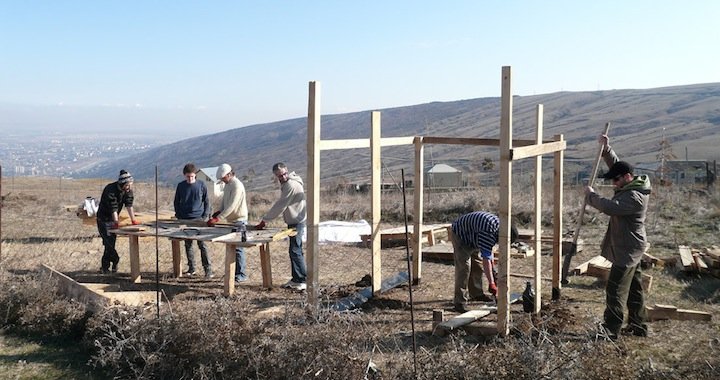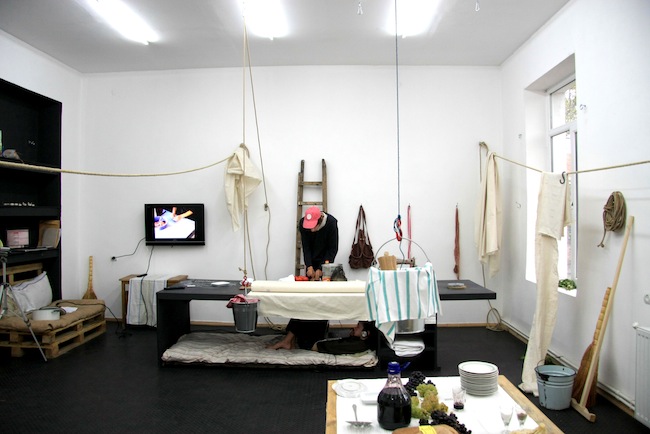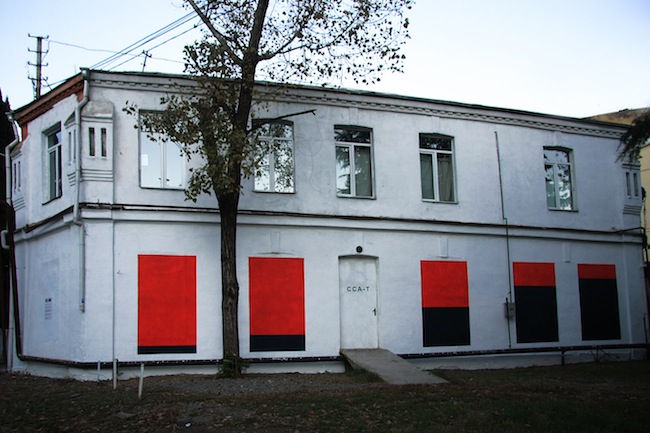
The Centre of Contemporary Art
Laura Ķeniņš
28/05/2013
Wato Tsereteli is an artist, art educator and director of the Center of Contemporary Art Tbilisi in Tbilisi, Georgia. Completing his education in film in Tbilisi and a master’s degree in photography at the Academy of Fine Arts in Antwerp, Belgium, Tsereteli has been active in all facets of the Georgian art scene since the late 1990s, working tirelessly to organize, educate, research, curate and create. Located (for the moment) on a leafy side street along Tbilisi’s Mtkvari River, the Center of Contemporary Art offers exhibitions, events and an “informal master’s program,” as well as a research centre. Looking to bring Tbilisi closer to the global “centre of contemporary art” or the global centre closer to Tbilisi, the Center of Contemporary Art started to fill a gap in a space to see, create and participate in contemporary art in Georgia, which has no permanent contemporary art museum or centre. Speaking with Tsereteli, who travels regularly around Europe and globally to speak and instruct, works in video, photography, animation and other media, teaches in the centre and the Tbilisi State Art Academy, writes, runs the centre, and is also the parent of a toddler, one wonders how he possibly has time to sleep or eat – yet our interview feels anything but rushed.
How long have you been working at the contemporary art centre? How did you go from being a practicing artist to being an arts administrator?
It’s been in existence since October 1, 2010. I set it up.
Normally I’m an artist but I considered that this is also a creative work for me: to do something from nothing. We started with nothing here, I didn’t have any advice or support. Now we have the arts centre and a school here and I’m also doing lecturing internationally about creativity. It’s also community-based. Artists are trained creative people: trained in professional creativity. It’s not just about being trained to be an artist but also how to be professionally creative. This can be applied all over; the institution can also be seen as professional creativity.
Are you still making art?
I studied photography and film, but I do everything. Most recently I’ve been making video essays – personal narrative essays in video form.
How did you move into arts administration?
I didn’t move. For me, it’s a long-term performance. I think the centre is an artwork itself. To contextualize, in Georgia you don’t have independent art institutions. You don’t have underground art. If you do an installation somewhere, it isn’t underground, because everything is underground.
I’m doing this not because I like administration, but because nobody else is doing it.
Legally, our name is the Center for Contemporary Art. But “for” sounded too engaged for me, so I wanted it to be more relaxed: the centre of contemporary art. “Of” is a mistake in this context, English people told me, like geographic centre. And Tbilisi isn’t the centre of anything…
But it fits.
Normally, you have Europe-centred maps, and sometimes you see these other versions, Asia-centred maps or Africa-centred maps. For the 2001 Venice Biennale, I made a Georgia-centred map…it was quite popular.
So the centre of contemporary art is in Tbilisi?
It’s not really literary.
How is it a performance?
We work on a hybrid economy here: we don’t pay rent, for example. Maybe that doesn’t work everywhere, but you can do it here if you try. We are moving this year, and we have to move because that’s one of the problems with not paying rent, you can’t stay in a space for very long, but we don’t pay rent.
We avoid money, we exchange with other things. For example, we have a school, and some students make documentation [of our events] instead of paying, some help with finances instead. When we need something, we look at how we can get it without money; the starting point is what you can do without money.
-2.jpg)
Wato Tsereteli
Tell me more about the school.
We call the school an “informal master’s.” The master’s is so formalized, so over-formalized, so we wanted to create an informal masters.
We have two innovative programs: one is called Mediation, or maybe a better term is Context Production. This course aims to experiment with what can be a context: what kind of opportunities there are for art to meet audiences. It’s more forward-thinking than curatorial studies. Curatorial studies is outdated, especially after the economic crisis. There isn’t so much work for professional curators. Our program is very successful. Students get a lot of professional attention.
The other program, which is mandatory for all students, is about farming and art, looking at organic farming. Students go and work on the farm of artist Mamuka Japharidze, in Shindisi, outside of Tbilisi, and learn more about organic farming, This is not to bring potatoes into the gallery, but to combine farming with creative thinking, to look at nature as medium –
Like land art?
No, not like land art.
I invented this program when I was on a plane. We receive support from the Swiss Embassy, international financing, and also sometimes the Georgian government, for specific projects.
How is the master’s program “informal”?
I work in the art academy as well, and there is a very big difference. One of the differences is the flexibility. The world is changing very quickly and you must be flexible. Academia doesn’t change that quickly.
Our programs last nine months. In Georgia, if you have a program of less than nine months, you don’t need a license, so we made the program nine months.
If you want to add a program in curatorial studies in the art academy, you can do that, but you have to go through the licensing, the board, and it’s already out of date. Reality changes, but education is still in another decade.
And the students, are they at the same level as students in regular master’s programs: for instance they’ve completed their bachelor’s or something similar?
In a way.
I studied at the Royal Academy of Fine Arts in Antwerp for my bachelor’s degree. This was before the Bologna reforms took effect, to allow for more mobility in education between European countries. There was a shift – I noticed this shifting twice, in Antwerp and in Tbilisi. What was expected of a BA is now expected of an MA. It’s an artificial degradation.
Students are spending more time in university to get a master’s degree that means less than a bachelor’s used to. And previously, you would spend a year or two learning basics, and then the rest of the time in the studio, developing your work. Now with the reforms, that basic information is spread out over longer, and you don’t have that time to develop your own work. You have students at the master’s level doing work that students were previously doing at the bachelor’s level. People graduate and they haven’t developed these basic skills and they haven’t developed their own work. It’s a dumbing-down of the education system.
With Bologna, it’s a mess. At the end of the BA, you are neither personal nor professionally developed.
Do you have students from other countries here?
We have 16 students. Sometimes we have students who want to come on an exchange…We also receive support from the German organization DVV International [for adult education]. DVV has “informal education” written into their priorities for funding. They are supporting international content. They allow ten students from socially disadvantaged families to study for free, from different countries. But mainly we are here for Georgians, and others in the region, Armenia, Azerbaijan…
You called your program successful?
The program is project-based. Students have to make and produce events. Their portfolio and events are already public during their studies. So these events receive critical attention. The students are also publishing a newspaper once a month.
In many ways, this centre is a kind of a station. We leave [the students] to real life. They are working in reality, not within the ephemeral academy.
In the mediation course, one project is to make something inside a closed society. For example, one guy went to a centre for homeless people, where he learned that one lady wrote stories; she wrote a story about him, and he did an art project about it.
We bring international art to the Georgian public and Georgian artists to the international public. Anyone who comes to Georgia and Googles “centre of contemporary art” will find us. If people are visiting, we invite them to come and give presentations. You can come here and get information, or you can sit and read a book.
You mentioned that before you started the centre, people were coming to you to find out about Georgian contemporary art.
People who were interested in Georgian art were approaching artists directly. They were coming to people’s homes, to studios. This can be interesting, but it’s still people’s homes, it’s not open. If you are shy, you can’t go there, but if you are shy, you can come here. Basically, for shy people, we did this.
We also initiated the Tbilisi Triennial, which is focused on art education. We all recognize that art education is important, but I think the art world is not reacting out to the problems of it. The first Triennial was held in October 2012. We invited representatives from 13 art schools operating without accreditation, from Korea to Addis Ababa to Zurich. These platforms are much more up-to-date [than traditional art academies]. There was an exhibition about education as well: how do you show it in a space? Education needs dramaturgy.
In Berlin, there is a summit of independent art schools, but it’s just a meeting. This was also an exhibition, and more of a biennale. We are already thinking about the next one in 2015.

Installation by J.Morgan Puett at the 1st Tbilisi Triennial - Offside Effect
Will the next one be bigger, or the same, or different in some way?
Our emphasis is quality, not size, so we will look towards how to make it better. We will also have a publication from the last triennial. There will be a presentation in Venice [at this year’s Biennale]. I’m thinking to make a larger book as well, about the historical context of independent art education.
How long has the school been operating here?
The school has been here since 2010, from the beginning, but I have been running schools since I was 23…In 1998 or 1999, when I came back from Antwerp, I started to develop an institute for photography. At the time, there was no program in photography at the art academy. We were accredited in the beginning, but then the rules changed. We either had to close it, or integrate with the Art Academy – basically, the same. (Laughs)
Then, in 2005, it was integrated into the Art Academy. It became the photography department. I am the head of the department of photography there now. It is very different from the rest of the academy.
After that, I started to think more about the informal education. With a friend, we ran a school as a bar and a party place for a year. The most important thing, which we had here was a collaborative practice – we had more people involved than in a usual master/pupil situation.
How did that work?
I was buying beer and VJing every weekend for a year; after a year, I got tired.
Are people also learning there—while they are partying?
Well – they forget! (Laughs)
We had a final show for the students at the Villa Arson in Nice, France. It was a very big thing for them. This was self-made, a community thing.
The dramaturgy is very important in education. Starting the school is an education in itself: how to start a story, keep people interested. There is a book by Carlos Castaneda, The Teachings of Don Juan, an anthropologist, he writes about how to start a school. He tells students to take magic mushrooms – this way you lock them in, keep them interested.
So you give your students magic mushrooms?
No (Laughs). It’s about dramaturgy: you give people conditions that are interesting, learn to put theory into reality.
Tell me more about the farm program.
It takes place in the town of Shindisi – it’s a residency. The students go to live on the farm and work there, learning about organic farming.
When somebody asks how I represent the Centre of Contemporary Art, I think about the farm. About the importance of farming, of our food. What I understood from farming in education is that it’s not only ecology, it’s about going to another place.
Is organic farming popular in Georgia right now?
Yes, yes, people understand that what you’re sold at the store is poison.
What do students do after the program?
Some stay working with us, some got their own space in Rustavi, Georgia’s second biggest city, and started a 700 m2 community project with farming. It’s important that we make conditions for people to develop themselves.
We have the school, the gallery, and a research department here. We are working on writing an art history of the 20th century, coordinating authors – not the Soviet art history, but to write about what really was art history in Georgia.

What are you doing with the research?
Right now, the real artists are not a part of art history. We are bringing them back.
There have been many small projects – we’re working on a complete overview.
In the first stage, we’re making six issues of a newspaper. This is cheap and easy to print. These six issues will become six chapters of a book.
Like a serialized novel.
Yes – it’s bilingual, in English and Georgian. The project is supported by an Austrian contemporary art platform.
Many of the young Georgian artists whose work was recommended to me are not living in Georgia. Do young artists feel they need to leave Georgia to have a career?
Maybe it’s not about a career, just a desire to see the world. But I am trying to create a situation here where young people don’t need to leave the country to have interesting experiences. First become an interesting artist, then you can leave to do residencies and so on. It is a sensitive time…I suggest to people, firstly to orient themselves and make their artistic practice interesting.